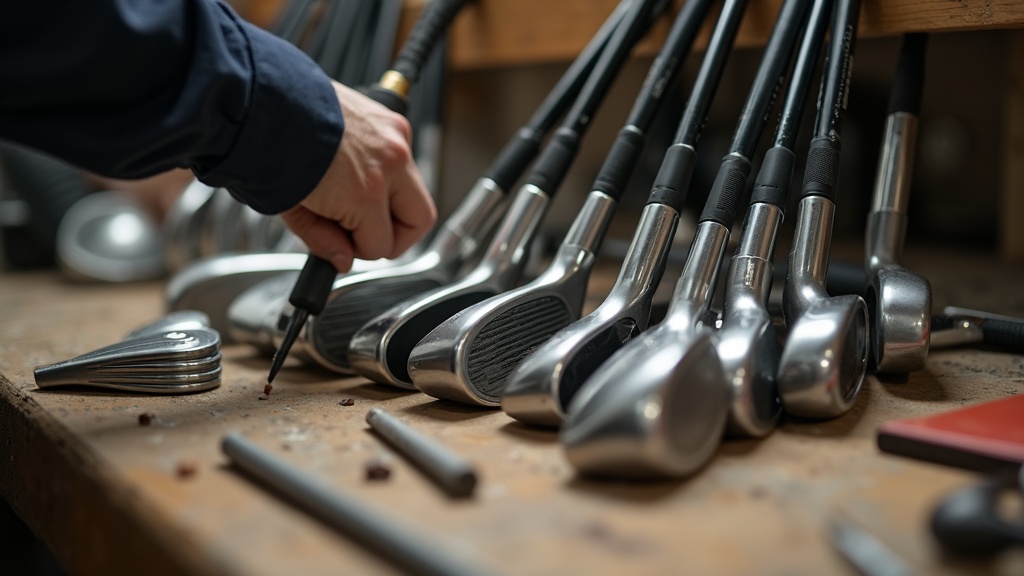Getting a set of custom fitted golf clubs has become a pretty big game changer, both for newbies and more seasoned golfers wanting to up their play. Club fitting is not just for tour pros; there’s a ton of value for anyone wanting to hit straighter, more consistent shots. I’ll walk you through how custom fitting works, what to expect, and why it’s worth checking out if you want to match your clubs to your swing and style.

Why Custom Fitting Golf Clubs is Worth Doing
Getting fit for clubs isn’t just about getting a set that looks cool. Off the rack clubs are built with a “onesizefitsmost” approach, and that rarely matches your height, swing speed, grip preference, or skill level perfectly. I’ve played with stock sets before, and it’s easy to notice how shots either slice off to the side or just don’t feel smooth. Properly fitted clubs can mean fewer mishits, longer shots, and more confidence on the course.
Golf might seem like a “mental game,” but having clubs tailored to you takes a load off your mind during those tricky shots. According to Golf Datatech research, players who get fitted see on average a few strokes shaved off their round. That kind of improvement feels pretty sweet, whether you’re just playing for fun or keeping score every weekend.
The main benefits of custom club fitting include:
- Better consistency: When clubs are the right length, lie angle, and shaft for you, your swing feels the same shot after shot.
- More distance: The right shaft flex and head design can really help you squeeze some extra yards without swinging harder.
- Higher confidence: Knowing your clubs actually work with your natural swing takes some stress off, especially in tough situations.
Another bonus: custom fitting often gets you thinking a bit more about your swing. When you see the instant feedback from the fitting session, you can start spotting areas for small tweaks in setup or swing path. Little adjustments, paired with clubs that actually suit your game, combine to make frustrating misses far less common.
How Custom Club Fitting Works: The Process Start to Finish
The idea of custom fitting might sound intimidating, but it’s actually pretty straightforward. Most major golf shops and club manufacturers offer some sort of fitting experience, and you don’t need to be a “serious” player to take part.
Here’s an overview of the typical fitting process I’ve seen and gone through:
1. Player Interview
The fitter wants to know your level of play, what your usual ball flight is, and what you want from new clubs; maybe extra distance, more accuracy, or forgiveness on bad swings. This chat is a big help in figuring out what to test.
2. Swing and Physical Measurements
They’ll measure your height, arm length, and wrist-to-floor distance. This helps zero in on shaft length and lie angle. Using a launch monitor, the fitter checks your swing speed, tempo, and how you actually strike the ball. You’ll hit a few shots with your own clubs or demo clubs.
3. Testing Equipment Options
Different shaft flexes, clubhead shapes, lofts, and grips get put into play. The fitting bays let you try out dozens of combinations, usually watched by computer sensors tracking how each club performs. I always find it fun to see instant feedback on your launch, spin rate, and ball speed.
4. Data Analysis
All those swing results get crunched by the fitting software. The fitter explains which setup gives you the best ball flight and why. It might surprise you; sometimes a softer shaft or a heavier grip gives way better results than what you expect.
5. Final Club Build and Recommendations
Once you settle on what works best, the shop builds your custom clubs to those exact specs. Turnaround can vary, but shops usually keep you in the loop. Most fitters hand you a full spec sheet so you always have your custom details handy for future club purchases or adjustments.
For many golfers, this process helps take the guesswork out of club upgrades. You don’t have to wonder if a particular driver or iron is “right” for you—the numbers and feel make the decision far easier.
Key Elements of a Proper Club Fitting
A good club fitting covers all the details. Here are some of the variables that really matter and why they’re super important for matching clubs to your personal swing style and needs:
- Shaft Length: Impacts how you address the ball and controls swing path. Too long can make you wild; too short and you might lose distance.
- Shaft Flex: Getting the right flex helps you launch the ball higher or lower and keeps shots on target. Fast swings usually need stiffer shafts.
- Lie Angle: A club that’s too upright or flat will cause shots to veer right or left. Proper lie means straighter shots.
- Grip Size: Grips that are too thick or thin can ruin your feel and mess with your release through impact.
- Loft & Head Design: Different heads offer more forgiveness or workability, depending on your goals. Loft changes how high the ball launches.
The fitter will adjust one variable at a time and watch how your ball flight reacts. It’s amazing to feel a club finally “click” and send shots flying the way you want. Even changing just the grip makes a huge difference sometimes. For example, switching from a standard grip to a midsize or an undersize can improve comfort and reduce tension, which overall helps you swing more naturally.
Tips for Getting the Most from a Club Fitting Session
Going into a custom fitting without any idea what to expect can feel a little awkward, but a little prep makes things smooth. Here are some pointers I share with friends before their first fitting:
- Bring your current clubs so the fitter can compare results and see your starting point.
- Wear golf shoes and bring a glove. You want it to feel like a real round.
- Don’t stress about swinging “perfectly” for the computer. The goal is to get clubs that work on your regular swings, not your best ever shots.
- Be honest about your goals and limitations. If you struggle with a slice or slow swing speed, let the fitter know; they’ll recommend clubs that help, not just what’s trendy.
- Plan to spend at least an hour (sometimes more for a full bag fitting), so set aside enough time to try out all your options.
Also, it helps to check in with your fitter about things you like or dislike in your current set. Small preferences—like how a grip sits in your hand or how heavy a club feels—make a major difference in the final recommendation. Remember, these sessions are all about making you comfortable and confident as you stand over each shot.
Common Myths About Custom Fitting
I hear a lot of myths about custom fitting, especially from golfers who think it’s only worth doing for low handicappers or tournament pros. Here’s what I’ve found from a lot of fittings and chats with experts:
- Custom fitting is only for good golfers: Actually, newer golfers stand to gain the most from clubs matched to their abilities. Misfit clubs make learning way harder.
- It’s too expensive: Many major brands now include free or discounted fittings if you buy clubs from them. Even if you pay a bit, the benefits are way better than blindly buying new clubs that don’t fit.
- Off the rack clubs are fine for most people: Some get lucky, but most end up working around awkward specs. Proper fit feels better and helps you improve faster.
Another common myth is that custom fitting requires special talent or athleticism, when in reality the process is built around your unique swing. Even seniors or juniors notice big benefits when their equipment matches their frame and style. Ultimately, the main goal is to reduce frustration and inject more enjoyment into the game—something every golfer craves.
When to Get Fitted: Timing and Frequency
If you’re new to the game, I suggest getting an initial fit early; poor fitting clubs make learning frustrating. Upgrades to a full bag fitting make sense when you’ve settled into your swing (usually after you’ve played a season or two). Experienced golfers might refit every couple of years or when their swing changes from lessons or injuries.
Juniors and young players should get checked every year or as they grow. The more you play and practice, the more helpful a fit can be as your swing develops. Seasonal checks, especially after winter breaks or physical changes, will keep your clubs working in sync with your evolving swing.
Quick FAQ: Custom Fitting Answers
Do fittings include putters and wedges, or just irons and drivers?
Most fullbag fittings include everything, including putters and wedges. Putter fittings are super underrated; getting the right length and loft on your putter can save a lot of strokes.
How long does a typical fitting last?
Usually at least an hour for irons or drivers. A full bag fit can take up to two hours, especially if you want to test a lot of options and go over every spec.
Should I get fitted if I’m still a beginner?
Yes, because playing with clubs that match your body makes learning faster and way less frustrating. A fitting doesn’t just shave strokes; it makes the game feel easier right away.
Can I use my own grips or shafts?
Absolutely. Most fitters can accommodate personal grip or shaft preferences, or suggest tweaks based on your needs. If you have favorite components, bring those up in your session.
Are Custom Clubs Worth It?
I’ve seen golfers stick with clubs that honestly made the game harder when just a few tweaks (like a different shaft or new grips) would have made a world of difference. While getting fit might feel like a splurge, compared to guessing with off the shelf gear, it just makes sense for anyone committed to playing better, no matter your ability. Plus, knowing your specs makes it easier to shop, trade, or upgrade with confidence in the future.
Exploring a fitting session is a great investment in your game. If you’re interested in specific brands or want to find a fitter near you, checking out manufacturer websites or asking at your local pro shop is a solid place to start. Watching your drives and irons actually go where you aim is one of the most satisfying feelings in golf. Bottom line: custom fitted clubs give you a better chance at enjoying every swing and seeing real improvement, whether you’re out with friends or grinding on tournament day.
